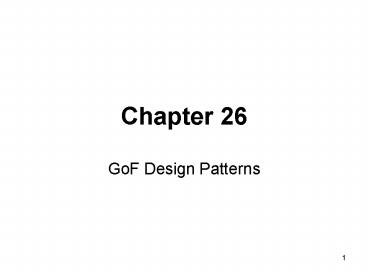GoF Design Patterns - PowerPoint PPT Presentation
Title:
GoF Design Patterns
Description:
Chapter 26 GoF Design Patterns – PowerPoint PPT presentation
Number of Views:210
Avg rating:3.0/5.0
Title: GoF Design Patterns
1
Chapter 26
- GoF Design Patterns
2
The Adapter Design Pattern
3
Interaction Diagram for Adapter
4
Sometimes we update domain models to reflect our
more refined understanding of domain
5
The Factory Pattern
6
The Factory Pattern
- Advantages
- Separate the responsibility of complex object
creation into cohesive helper objects - Hide potentially complex creation logic
- Allow optimizations to enhance performance
- Object caching Create objects beforehand and
keep them in memory for quick use. - Re-cycling Pool of connection threads in a
web-server. - ServicesFactory
- Data-driven design Class loaded dynamically (at
run time) based on system property. - Can create other adapter classes by changing
property value
7
The Singleton Pattern
- Issues with the factory pattern
- Who creates the factory itself?
- How do we get access to the factory class from
everywhere?
8
Accessing the Singleton
public class Register public void
initialize() ... aa ServicesFactory.getI
nstance().getAccountingAdapter() ...
9
The Singleton Pattern Implementation and Design
Issues
- Lazy initialization
- public static synchronized ServicesFactory
getInstance() - if (instance null)
- instance new ServicesFactory()
- return instance
- Eager initialization ???
10
The Singleton Pattern Implementation and Design
Issues
- Lazy initialization
- public static synchronized ServicesFactory
getInstance() - if (instance null)
- instance new ServicesFactory()
- return instance
- Eager initialization
- public class ServicesFactory
- private static ServicesFactory instance
- new
ServicesFactory() - public static ServicesFactory getInstance()
- return instance
11
Singleton Issues
- Lazy vs. eager initialization. Which one is
better? - Laziness, of course!
- Creation work (possibly holding on to expensive
resources) avoided if instance never created - Why not make all the service methods static
methods of the class itself? - Why do we need an instance of the factory object
and then call its instance methods?
12
Singleton Issues
- Why not make all the service methods static
methods of the class itself? - To permit subclassing Static methods are not
polymorphic, dont permit overriding. - Object-oriented remote communication mechanisms
(e.g. Java RMI) only work with instance methods - Static methods are not remote-enabled.
- More flexibility Maybe well change our minds
and wont want a singleton any more.
13
The Strategy Pattern
- Issue Provide more complex pricing logic.
- Pricing strategy varying over time
- Example Different kinds of sales.
14
Interaction diagram for Strategy
Context object
15
Context object has attribute visibility to its
strategy
16
Factory for Strategy Object
17
Factory Creates Strategy Object on Demand
18
The Composite Design Pattern
19
The Composite Design Pattern
20
The Composite Design Pattern
21
- public abstract class CompositePricingStrategy
implements ISalePricingStrategy
- protected List strategies new ArrayList()
- public add (ISalePricingStrategy s)
- strategies.add(s)
- public abstract Money getTotal( Sale
sale ) - public class ComputeBestForCustomerPricingStrategy
extends CompositePricingStrat
egy - Money lowestTotal new Money( Integer.MAX_VALUE
) - for (Iterator i strategies.iterator()
i.hasNext() ) - ISalePricingStrategy strategy
- (ISalePricingStrategy) i.next()
- Money total strategy.getTotal( sale )
- lowestTotal total.min( lowestTotal)
- return lowestTotal
22
Collaboration with a Composite
23
Abstract Classes and Methods in the UML
24
Creating a Composite Strategy
25
Creating the Pricing Strategy for a Customer
(Part 1)
26
Creating the Pricing Strategy for a Customer
(Part 2)
27
The Façade Design Pattern
- Additional requirement in new iteration of POS
Pluggable business rules - Example
- New sale might be paid by gift certificate.Only
one item can be purchased by a gift certificate - If sale paid by gift certificate, invalidate all
payments with the type of change due back to
customer different from gift certificate. - Some sales might be charitable donations by the
store. Limited to less than 250 each. Manager
must be logged in as cashier for this
transaction. - One of the concerns What happens to enterItem?
28
enterItem and Low Impact of Change
- Suppose architect wants low impact of change in
pluggable business rules. - Suppose also that the architect is not sure how
to implement the pluggable business rules. - Wants to experiment with different ways of
implementing them. - Solution The Façade design pattern
- Problem Need a common, unified interface to a
disparate set of implementations or interfaces - Solution Define a single point of contact to the
subsystem containing the implementations - This façade object has a unified interface
- Internal implementation details hidden
- Example The use-case controller objects in your
project.
29
The Façade Design Pattern
30
Façade code example
- public class Sale
- public void makeLineItem( ProductDescription
desc, int quantity)
SalesLineItem sli new SalesLineItem(
desc, quantity) - // call to the Façade. Notice Singleton
pattern if (POSRuleEngineFacede.getInstance().is
Invalid(sli,this) ) - return
- lineItems.add(sli)
- //..
31
Observer/Publish-Subscribe/Delegation Event Model
- Another requirement GUI window refreshes its
display of the sales total when the total changes - Later GUI updates display when other data
changes as well - Whats wrong with the following?
- When the Sale object changes its total, it sends
a message to a window, asking it to refresh the
display?
32
Publish-Subscribe Pattern
- Whats wrong with the following?
- When the Sale object changes its total, it sends
a message to a window, asking it to refresh the
display? - Answer The Model-View Separation principle
discourages such solutions - Model objects (objects in the domain) should not
know of UI objects - If UI changes, model objects should not need to
change
33
The Problem
34
(No Transcript)
35
Fig. 26.23
36
Fig. 26.24
37
Fig. 26.25
38
Fig. 26.26
39
Fig. 26.27































